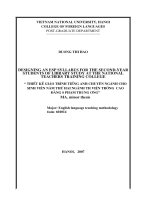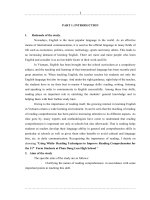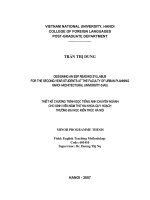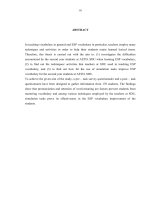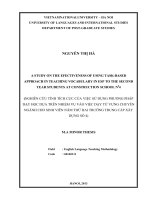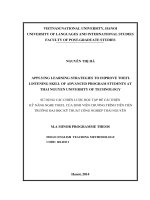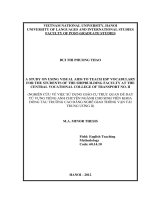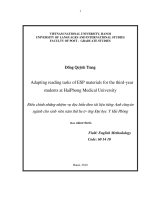Using project-based learning approach to improve ESP vocabulary for the second year students at Industrial Economics and Technology College
Bạn đang xem bản rút gọn của tài liệu. Xem và tải ngay bản đầy đủ của tài liệu tại đây (761.83 KB, 70 trang )
VIETNAM NATIONAL UNIVERSITY, HANOI
UNIVERSITY OF LANGUAGES AND INTERNATIONAL STUDIES
FACULTY OF POST-GRADUATE STUDIES
*********************
PHẠM THỊ KHÁNH LINH
USING PROJECT-BASED LEARNING APPROACH TO IMPROVE ESP
VOCABULARY FOR THE SECOND- YEAR STUDENTS AT INDUSTRIAL
ECONOMICS AND TECHNOLOGY COLLEGE
Sử dụng phương pháp học theo dự án để trau dồi từ vựng Tiếng Anh
chuyên ngành cho sinh viên năm thứ hai tại trường Cao đẳng
Công nghệ và Kinh tế Công nghiệp
M.A MINOR PROGRAMME THESIS
FIELD: ENGLISH TEACHING METHODOLOGY
CODE: 60140111
Hanoi, 2015
VIETNAM NATIONAL UNIVERSITY, HANOI
UNIVERSITY OF LANGUAGES AND INTERNATIONAL STUDIES
FACULTY OF POST-GRADUATE STUDIES
*********************
PHẠM THỊ KHÁNH LINH
USING PROJECT-BASED LEARNING APPROACH TO IMPROVE ESP
VOCABULARY FOR THE SECOND- YEAR STUDENTS AT INDUSTRIAL
ECONOMICS AND TECHNOLOGY COLLEGE
Sử dụng phương pháp học theo dự án để trau dồi từ vựng Tiếng Anh
chuyên ngành cho sinh viên năm thứ hai tại trường Cao đẳng
Công nghệ và Kinh tế Công nghiệp
.
M.A MINOR PROGRAMME THESIS
FIELD: ENGLISH TEACHING METHODOLOGY
CODE: 60140111
SUPERVISOR: DƯƠNG THU MAI, PhD.
Hanoi, 2015
DECLARATION
I certify that this minor thesis entitled “Using project-based learning approach to improve
ESP vocabulary for the second year students at Industrial Economics and Technology
College” is the study of my own research and the substance of this research has not
been submitted for a degree to any other university or institution.
Thai Nguyen, September, 2014
Signature
Pham Thi Khanh Linh
i
ACKNOWLEDGEMENTS
I would like to express my gratitude to all those who have given me great
assistance in the completion of my research work.
In the first place, I would like to express my deepest gratitude to my supervisor
Duong Thu Mai, Ph.D, who has provided me with insightful discussion, helpful
comments, valuable support in the preparation and completion of this thesis. Without
her guidance and help, this work would not have been accomplished.
Secondly, my sincere thanks also go to all lecturers and staff of the faculty of
Post- Graduate studies for their valuable lessons and precious helps. Thanks to their
lessons as well as needed helps, I could overcome enormous obstacles when doing the
study.
I also wish to acknowledge the cooperation of my colleagues and the secondyear students at Industrial Economics and Technology College in contributing to the
data collection presented in this study.
Last but not least, I would like to express my deepest thanks to my mother for
her encouragement and great support during my time of fulfilling this thesis.
ii
ABSTRACT
English for specific purposes has been taught in universities and colleges in
Vietnam for several years and it partially meets student’s needs. However, how to
teach and learn vocabulary for English for Specific Purposes well is still a challenge
for both teachers and learners. Besides, it seems that very little research has been
implemented on using project based learning in teaching ESP vocabulary. The
objective of this study is to investigate the attitudes of students and teachers at IETC
about project-based learning in teaching vocabulary in an ESP course. Four tools of
data collection which were employed in this study are a questionnaire for 70 students,
interviews for three teachers, learners’ diaries and document analysis. After data was
received from the questionnaire, it was analyzed in charts, and the information from the
teachers’ interviews was summarized interpretively. The results of the study show that
both students and teachers at Industrial Economics and Technology College think that
PBL is a fairly interesting and effective method in learning and teaching ESP
vocabulary. This suggests that the use of PBL is recommended to be further applied for
ESP courses at IETC.
iii
TABLE OF CONTENTS
DECLARATION .............................................................................................................i
ACKNOWLEDGEMENTS ...........................................................................................ii
ABSTRACT .................................................................................................................. iii
LIST OF ABBREVIATIONS......................................................................................vii
LIST OF FIGURES ................................................................................................... viii
P A R T A : INTRODUCTION ..................................................................................... 1
1. Rationale .................................................................................................................. 1
2. Objectives of the study ........................................................................................... 2
4. The scope of the study ............................................................................................ 3
5. Research methods ................................................................................................... 3
6. Design of the study.................................................................................................. 3
PART B: DEVELOPMENT.......................................................................................... 5
CHAPTER I. LITERATURE REVIEW ..................................................................... 5
1.1 English for Specific Purposes. ............................................................................. 5
1.1.1 Definitions .......................................................................................................... 5
1.1.2 Special features of ESP ..................................................................................... 6
1.2 Performance-based Assessment and Project-based learning. .......................... 7
1.2.1 Performance-based Assessment. ...................................................................... 7
1.2.1.1. Performance-based Assessment. .................................................................. 7
1.2.1.2. Approaches of Performance-Based Assessment ......................................... 8
1.2.2. Project- based learning .................................................................................... 9
1.2.2.1. Definitions ...................................................................................................... 9
1.2.2.2. Advantages of Project-Based Learning. .................................................... 10
1.2.2.3. Types of Projects.......................................................................................... 11
1.2.2.4 Process of project-based work..................................................................... 11
iv
1.2.2.5 Project- based learning in ESP.................................................................... 12
1.3 Vocabulary .......................................................................................................... 14
1.3.2 Aspects of vocabulary teaching. ..................................................................... 15
1.3.3 Vocabulary acquisition ................................................................................... 17
1.3.4 ESP vocabulary teaching ................................................................................ 18
1.3.5 Vocabulary projects. ....................................................................................... 18
1.5 Previous studies in the world and in Vietnam. ................................................ 20
CHAPTER II. RESEARCH METHODOLOGY ...................................................... 23
2.1. Teaching and learning ESP vocabulary at IETC. .......................................... 23
2.1.1. Teachers........................................................................................................... 23
2.1.2. Students ........................................................................................................... 23
2.1.3. The textbook.................................................................................................... 24
2.1.4. The project ...................................................................................................... 24
2.2. Research Design ................................................................................................. 25
2.2.1 Research Method ............................................................................................. 25
2.2.2 Participants ...................................................................................................... 26
2.2.3 Data collection .................................................................................................. 26
2.2.2.1. The questionnaire ........................................................................................ 27
2.2.2.2. Interviews ..................................................................................................... 28
2.2.2.3. Document Analysis ...................................................................................... 29
2.3. Data analysis procedures .................................................................................. 30
CHAPTER III: FINDINGS AND DISCUSSION ..................................................... 32
3.1. Students’ general attitude towards using PBL in learning ESP vocabulary
(Research Question 1). ............................................................................................. 32
3.1.1 Students’ attitude towards learning ESP vocabulary through the project.
.................................................................................................................................... 32
3.1.2 Students’ attitude towards teacher’s help in doing the project. ................. 34
v
3.1.3 Students’ attitude towards interest and motivation of the project ............. 34
3.1.4 Students’ attitude towards the content of the project. ................................. 35
3.1.5 Students’ attitude towards the aims of the project ...................................... 36
3.1.6 Students’ attitude towards group work in doing the project. ..................... 37
3.1.7 Students’ difficulties in doing the project. .................................................... 38
3.2 Teachers’ attitude toward PBL (Research Question 2) .................................. 39
3.3 The extent that the project met the project objectives (Research Question 3)
.................................................................................................................................... 42
3.4 Discussion ............................................................................................................ 43
PART C: CONCLUSION............................................................................................ 45
1. Recapitulation ....................................................................................................... 45
2. Main findings ........................................................................................................ 45
3. Limitations of the study ....................................................................................... 46
4. Suggestions for further study .............................................................................. 47
REFERENCES ............................................................................................................. 48
APPENDICES ................................................................................................................ I
vi
LIST OF ABBREVIATIONS
PBL: Project- Based Learning
PBA: Performance- Based Assessment
ESP: English for Specific Purposes
IETC: Industrial Economics and Technology College.
vii
LIST OF FIGURES
Figure 3.1: Students’ attitudes towards PBL improvement
Figure 3.2: Students’ attitudes towards the teachers’ help
Figure 3.3: Students’ attitudes towards interest and motivation
Figure 3.4: Students’ attitudes towards content of the project
Figure 3.5: Students’ attitudes towards aims
Figure 3.6: Students’ attitudes towards group work
Figure 3.7: Students’ difficulties
Figure 3.8: Document Analysis of the final products
viii
P A R T A : INTRODUCTION
1. Rationale
English has become an international language and a very important and compulsory
subject at schools because of the development of science, technology and economy in
the world. The process of globalization have demanded us to use English in all fields
with various activities which require special linguistic competency such as technical
English, scientific English, medical English, English for business, English for political
affairs, and English for tourism...As a result, English for Specific Purposes has become
an important subject at universities and colleges to meet students’ needs when they
graduate and find jobs.
English for Specific Purposes has been taught at IETC for some years. It partly
meets the students’ needs. However, ESP is still a new subject for both teachers and
students, making both have difficulties in the teaching and learning process, especially
in teaching and learning ESP vocabulary. It is also an important aspect in teaching and
learning ESP. British linguist Wilkins (1972: 111) once said that “Without grammar,
little can be conveyed; without vocabulary, nothing can be conveyed”.
Meanwhile, project-based learning approach is said to be an effective way which can
help increase students’ motivation, which can improve not only all skills (listening,
speaking, reading, writing) in language learning but also other ones in society. PBL is
considered as a bridge between classroom and reality. According to Blumenfeld et al.,
(1991: 372), “projects can serve to build bridges between phenomena in the classroom
and real-life experiences; the questions and answers that arise in their daily enterprise
are given value and are shown to be open to systematic inquiry”. When doing project
works, students have to use English, so they have a chance to improve their English.
Also, they will obtain knowledge, information about the real world or their major as
well as several social skills. In Vietnam, the project “Intel Teach to the Future” has been
implemented by Ministry of Education and Training and Intel Vietnam in order to
1
experience PBL in teaching since 2003. By 2005, there were 2.340 teachers all over the
country taking part in this program. PBL has been used as a new and interesting approach
in teaching at schools and universities.
Besides, teaching and learning ESP vocabulary is not as very successful as what
IETC’s teachers and students expect. It is still a challenge for both teachers and
learners in general and for the ones at IETC in particular. Because of these reasons, this
action research was done on the situation of the teaching and learning ESP vocabulary
entitled: “Using project-based learning to improve ESP vocabulary for the second-year
students at Industrial Economics and Technology College.”
2. Objectives of the study
With the reasons above, this study was conducted with these following main ones:
To explore the students’ and teachers’ attitudes towards project-based learning.
To see positive aspects and the difficulties that the students at IETC meet when
they learn English for Specific Purposes vocabulary as well as problems that the
teachers at IETC get when they teach ESP vocabulary.
To investigate the extent of the ESP vocabulary project that meet the project
objectives.
3. Research questions
With the aims stated above, three following questions were proposed for the
study:
1. What are students’ attitudes to the project- based learning?
2. What are teachers’ attitudes to the project- based learning?
3. To what extent does the students’ ESP vocabulary projects meet the
project objectives?
2
4. The scope of the study
As mentioned in the research methodology, this is an action research. The subjects
of the study include 70 second-year, non-major English students and three EFL
teachers at Industrial Economics and Technology College.
Due to the limitation of time and scale of a minor thesis, it is impossible to cover
every aspect of language theory and practice in this study, the study only focused on
investigating the targeted students’ and teachers’ attitudes towards using PBL in
teaching and learning ESP vocabulary and extent of the project that met the project
objectives measured by the questionnaire responses, interviews and document analysis.
5. Research methods
The study was conducted as an action research.
Different methods of an action research were used. They are a questionnaire,
interviews, learners’ diaries and document analysis. These methods were used to
collect data from the students and teachers at IETC as well as from students’ products.
A questionnaire was designed to investigate students’ attitudes and their main
difficulties. After collecting the data from the questionnaire, the data was analyzed
qualitatively and quantitatively.
The second method – interviews. Teachers were interviewed to obtain clearer
view of teachers’ attitude towards the application of project-based learning at IETC.
Learners’ diaries were used to collect information for research question 1 and 3.
Document Analysis was used to explore which aspects of the projects met its
objectives. Documents include students’ final products of the project.
6. Design of the study
3
The thesis is entitled “Using project-based learning to improve ESP vocabulary for
the second-year students at Industrial Economics and Technology College.” The study
will be designed with three parts: Introduction, Development and Conclusion.
The first part, Introduction, is a brief overview of the study with more details of the
rationale, the objectives, the methods, the research questions, the scope of the study as
well as the design of the study.
The second part, Development, consists of three chapters. Chapter 1 is literature
review which presents the theoretical background of the thesis. This chapter consists of
definitions of key terms: project-based learning, vocabulary and ESP. A review of
previous studies is also put in this chapter. Chapter 2 begins with an overview about
teaching and learning ESP vocabulary at IETC. This chapter is also a deeper look on
the method used in the study with participants and data collection procedures as well as
data analysis one. Chapter 3 deals with the findings and discussion.
The last part, Conclusion, is devoted to the summary of the findings, limitations of
the study. This chapter also provides some suggestions for further study.
References and Appendices will be in the end.
4
PART B: DEVELOPMENT
CHAPTER I. LITERATURE REVIEW
This part reviews some authors’ viewpoints concerning with PBL, ESP and
vocabulary teaching in order to build up the theoretical background for the study,
which consists of four main parts: related issues of ESP, an overview of project-based
learning and vocabulary as well as overview of previous studies in the world and in
Vietnam about using PBL in language teaching.
1.1 English for Specific Purposes.
It is seen that the teaching of English for specific purposes is a separate activity
within English Language Teaching and ESP research as an identifiable component of
applied linguistics research. Since the early 1960s English for Specific purposes has
grown to become one of the most prominent areas of EFL teaching. The development
of ESP is reflected in the increasing number of universities offering an MA in ESP and
ESP courses for students.
1.1.1 Definitions
English for specific purposes has been defined by many writers and researchers in
the world. According to Hutchinson and Waters (1987:19), ESP is an approach to
language teaching in which all decisions as content and method are based on the
learner’s reason for learning. According to them, “ESP must be seen as an approach
not as a product” and “ESP should properly be seen not as any particular language
product but as an approach to language teaching which is directed by specific and
apparent reasons for learning.”(19)
Dudley-Evans and St. John (1998:4-5) also defined ESP by giving out
characteristics of ESP, both absolute and variable ones. Among them, three absolute
characteristics of ESP are: (1) ESP is designed to meet specific needs of the learners,
(2) ESP makes use of the underlying methodology and activities of the disciplines it
5
serves, (3) ESP is centered on the language (grammar, lexis, resister), skills, discourse
and genres appropriate to these activities.
The variable characteristics include: (1) ESP may be related to or designed for specific
disciplines, (2) ESP may use, in specific teaching situations, a different methodology
from that of General English, (3) ESP is likely to be designed for adult learners, either
at a tertiary level institution or in a professional work situation. It could, however, be
for learners at secondary school level, (4) ESP is generally designed for intermediate
or advanced students. Most ESP courses assume basic knowledge of the language
system, but it can be used with beginners.
Dudley-Evans and St. John had looked at the three definitions from Hutchinson and
Water (1987) and Strevens’ (1988). Strevens defined ESP by making a distinction
between four absolute characteristics and two variable characteristics. Clearly, DudleyEvans and John, M (1998) inherited and developed Strevens’s definition of the term.
1.1.2 Special features of ESP
Types of ESP
Linguists and researchers have tried to classify ESP by different criteria such as
experience and professional area. ESP has traditionally been divided into two main
areas: English for Academic Purposes and English for Occupational Purposes.
According to Carter (1983:20), there are three types of ESP:
(1). English as a restricted language: The language used by air traffic controllers
or by waiters are examples of English as a restricted language.
(2). English for academic and occupational purposes: English for science and
technology, English for Business and Economics, English for social studies, English
for academic purposes, and English for occupational purposes.
(3). English with specific topics: This type concerned with anticipated future
English needs of, for example scientists requiring English for postgraduate reading
studies, attending conferences or working in foreign institutions.
6
ESP as a learner-centered approach
ESP is known as a learner-centered approach to teaching English as a foreign or second
language. This approach considers knowledge as being an over-changing process,
which is built upon the learner’s prior experience (Hutchinson & Water, 1987:59f). A
learner-center approach provides opportunities for students to practice critical and
creative thinking, problem solving and decision making.
Carter (1983) also stated that an ESP course has three features. They are authentic
material, purpose-related orientation and self-direction. The use of authentic content
material, modified or unmodified in form is one of ESP features, particular in selfdirected study. Purpose-related orientation refers to the simulation of communicative
tasks required of the target setting. Carter (1983:134) said: “point of including selfdirection is that ESP is concerned with turning learner into users.” Or it can be said that
ESP is determined by students’ specific learning needs. Therefore, the learners must
have a certain degree of freedom to decide when, what and how they will study.
This part is a brief introduction of ESP definitions and specific features. The next
presentation will focus on another key term, PBL.
1.2 Performance-based Assessment and Project-based learning.
1.2.1 Performance-based Assessment.
1.2.1.1. Performance-based Assessment.
In recent years, a new approach has been applied in teaching and learning- that
is performance-based assessment. Performance assessments or authentic assessments
"represent a set of strategies for the...application of knowledge, skills, and work habits
through the performance of tasks that are meaningful and engaging to students"
(Hibbard and others, 1996:5). According to Shavelson & Baxter (1991) performancebased science assessments provide students with hands-on opportunities to demonstrate
their knowledge, not simply by recalling scientific facts but by constructing solutions.
In evaluating student performance there is an emphasis on the process by which
7
students generate solutions, not just on the correctness of the solution itself. Students
demonstrate their knowledge and skills in the course of their everyday work by solving
problems, doing mathematical computations, writing journal entries, conducting
experiments, presenting oral reports, and assembling portfolios of representative work.
It can be said that performance –based assessments involves having the students
produce a project, whether it is oral, written or a group performance. The students are
engaged in creating a final project that exhibits their understanding of a concept they
have learned.
There are two parts to performance-based assessments. The first part is a clearly
defined task for the students to complete. This is called the product descriptor. The
assessments are either product related, specific to certain content or specific to a given
task. The second part is a list of explicit criteria that are used to assess the students.
Generally this comes in the form of a rubric. The rubrics can either be analytical,
meaning it assesses the final product in parts, or holistic, meaning that is assesses the
final product as a whole.
Before PBL is introduced, it is necessary to mention PBA because PBA seems to be
a broader field covering PBL. In other words, PBL is one of many types of PBA.
1.2.1.2. Approaches of Performance-Based Assessment
Ferrara and Mctighe (1997) designed “Framework of Assessment Approaches
and Method” with 5 columns which are 5 assessment methods as well as examples.
According to them, approaches and methods of performance-based assessment include
constructed response (fill in the blank, short answer...), products (essays, reports,
portfolios, science project...), performances (oral presentation, debate,...) and processfocused (oral questioning, observation...).
Constructed response require test-takers to write brief responses that capture
their knowledge and thinking processes, create graphical representations of concepts,
or manipulate objects or text in certain ways to communicate their understanding.
8
Short- written answer and visual representation are said to be used widely. This method
takes less time to administer than other types of PBA.
Performance is the method that can help the teacher be able to observe the
application of desired skill and knowledge. It is widely used in certain disciplines such
as music, physical education. This method is extremely valuable when students apply
the scoring tools, making them put more effort. However, it may be time-intensive for
both teacher and students.
Process-focused provide information about students’ learning strategies and
thinking. This method does not focus on responses, products or performance, it focus
on the process of learning. It is used typically over time.
Project method is the one with which students’ products can provide application
of knowledge and skills. Teachers can evaluate written, visual, aural products or any
types of products to determine the proficiency and level of quality. The representative
sample of projects is portfolios.
As it is said before that performance –based assessment involves having the students
produce a project, whether it is oral, written or a group performance. Therefore, project
is considered as one type of performance-based assessment. In the next part, that type
of performance-based assessment will be deeper discussed.
1.2.2. Project- based learning
1.2.2.1. Definitions
Project- based learning has been used in several fields such as medicines,
educations, engineering...for many years. This term has been defined by researchers
and linguists. Project-based learning is a comprehensive instructional approach to
engage students in sustained, cooperative investigation as what Bransford & Stein
(1993) defined.
Adderly et al (1975:1) presented a good definition for the project method with
the following aspects: (1)[projects] involve the solution of a problem; often, though not
9
necessarily, set by the student himself, (2)They involve initiative by the student or
group of students, and necessitate a variety of educational activities, (3)They
commonly result in an end of product (eg: thesis, report,...), (4)Work often goes on for
a considerate length of time, and (5)Teaching staff are involved in an advisory, rather
than an authoritarian, role at any or all of the stages-initiation, conduct or conclusion.
Among them, the first and the third one is said to be important aspects of project-based
learning. According to Haines (1989), the project work was defined as multi-skill
activities which focus on a theme of interest rather than specific language tasks.
Among three definitions above, the one given by Adderly et al (1975) seems to be the
clearest and the most specific, so it is applied in this study.
1.2.2.2. Advantages of Project-Based Learning.
From the definitions above, we all know that project- based learning involve
learners in projects. Through projects, the learners have to use English; therefore, they
have chances to practice English, to learn English. Meanwhile, they have opportunities
to gain a lot of knowledge from the real world and develop different skills. Blumenfeld
et al., (1991: 372) mentioned the benefits of project-based learning clearly:
"...Project-based learning also places students in realistic, contextualized problemsolving environments. In so doing, projects can serve to build bridges between
phenomena in the classroom and real-life experiences... Projects are adaptable to
different types of learners and learning situations.... Projects can increase student
interest because they involve students in solving authentic problems, in working with
others, and in building real solutions (artifacts). Projects have the potential to
enhance deep understanding...because students need to formulate plans, track progress
and evaluate solutions" (372-373)
It is clear that PBL allows students to own their own work, discover their own
talent and interest. They have a chance to decide what to do for the project and when to
do in their learning process, which can help them improve self-directed learning. It is
10
clear that PBL is an approach which can bring a lot of advantages for learners in
learning process.
1.2.2.3. Types of Projects
There is a myriad of projects such as making news, portfolios, drawing pictures,
make records, carry out interviews and surveys..., so it is quite difficult to describe how
the project work is. North, S (1990) divided projects into four groups based on the
difference in the nature of the main resource: community projects, case studies,
practical projects and library projects. Haines (1989:1) identifies three types of projects
according to final products and information delivery: (1) Production projects which
foresee the work with radio, video, wall newspaper, etc. (2) Performance projects
involves presentation, debates,...and (3) Organizational projects which are connected
with parties, plays, dramma, ect. In term of data collection techniques and sources of
information, Hains (1989) also classified projects into 5 categories: Research projects
which include such kinds of work as reports, display; Survey project which may also
include displays, but more interview, summaries, finding; Text projects which deal
with
“text”
rather
than
people;
Correspondences
projects
which
involve
communication with individual, and Encounter projects which require face to face with
other people. Though there may be many types of projects, they have some common
characteristics and process. The next part will discuss this.
1.2.2.4 Process of project-based work.
There are different models in implementing a project. In other words, procedure
in project-based learning is different from each project, each linguists or each teacher.
This model of projects is suggested by professional development organizers at the
Buck Institute for Education (BIE) using the following five principles or stages:
1. Begin with the end in mind and plan for this end result.
2. Craft the driving question; select and refine a central question.
3. Plan the assessment and define outcomes and assessment criteria.
11
4. Map the project: Decide how to structure the project.
5. Manage the process: Find tools and strategies for successful projects.
(The Project Based Learning Handbook (2007) developed by the Buck Institute for
Education)
It can be seen that this model have only five steps, but in each steps there are more than
one requirement. The steps are so common and the work is not clear, so it is difficult
for the teacher to follow.
Sheppard & Stoller (1995, 1997) suggested teachers need to follow 10 steps when they
develop a project work.
Step 1: Students and instructor agree on a theme for the project.
Step 2: Determine the final outcome.
Step 3: Structure the project.
Step 4: Instructor prepares students for the demands of information gathering
Step 5: Gather information.
Step 6: Instructor prepares students to compile and analyze data
Step 7: Students compile and analyze information
Step 8: Instructor prepares students for the language demands of the final
activity
Step 9: Present final product.
Step 10: Evaluate the project.
It can be seen clearly that the two models more or less have same process in
implementing PBL approach in teaching. However, the model that Sheppard and
Stoller (1995) offered seems to be clearer and more specific. Each step in this model
has precise aim and is easy to follow. That is the reason why it became the structure
that the project in this study is based on.
1.2.2.5 Project- based learning in ESP.
At present, ESP is a subject that is offered for students at colleges, vocational
12
training centers and universities. Besides, in ESP teaching course it is vocabulary that
seems to be primary goal. Specialized words are more focused than grammar or
structures. PBL is a teaching approach which has been used by teachers aiming to teach
ESP vocabulary better. Recently, PBL has been heralded as an appropriate approach to
content-based second language education (Stoller, 1997), and ESP. Liuoliene, A and
Metiuniene, R (2013) said that PBL is a creative method of expanding ESP vocabulary
for student, but it is “the most challenging activities”. It is a creative and innovative
because it requires new habits of learning. It stimulates students thinking for
themselves, conduct researches, solving problems. In process, students not only
improve such skills but also acquire more academic knowledge about their major,
especially their ESP. In other words, PBL helps learners improve ESP vocabulary,
knowledge about their major and other related skills. However, this is a very
challenging method in teaching ESP vocabulary. One of the reasons is that this
approach requires teachers to have to set up projects which must be suitable for the
learners if they want their projects are successful. It is known that learners are usually
adults who want to learn ESP with particular purposes- for their future career. They
have motivations and clear goals in their learning, but their English may be advanced,
good or even not very good. This causes the teacher to have an extremely careful
choice of project which is suitable for learners to do.
1.2.2.6 Portfolio Assessment
Together with performance-based assessment which was mentioned above, portfolio
assessment is another instrument that supports PBL. It is said to be an authentic means
of assessment tools, more authentic than the traditional classroom test. So what is a
portfolio? Portfolios can consist of a wide variety of materials: teacher notes, teachercompleted checklists, student self- reflections, reading logs, sample journal pages,
written summaries, audiotapes of retellings or oral readings, videotapes of group
projects, and so forth (Valencia, 1990). However, a portfolio is not a random collection
13
of student products; it is systematic in that the student products that are included relate
to major instructional goals. Portfolio assessment also actively involves the students in
the process of assessment (Tierney, Carter, & Desai, 1991). The process of portfolio
assessment includes several steps some of which may need the conjunction of the
students and the teacher. This makes the students develop cognitive skills, engage them
actively and consolidate the teacher-student communication.
1.3 Vocabulary
This section is going to present vocabulary definitions, the role of vocabulary in
language teaching as well as aspects of vocabulary which need to be taught.
1.3.1 Definitions and the role of vocabulary in language teaching
The term vocabulary is used every day in language teaching, but what is
vocabulary? Is a word, a lexeme... vocabulary? Recent studies on vocabulary concern
with an understanding of “Lexis”, the Greek one for “word”, which “refers to all the
words in a language, the entire vocabulary in a language” (Barcroft, Sunderman and
Schmitt, 2011:571). Hornby (1995:1331) agreed with that idea, that it “is the total
number of words in a language; all the words known to a person or used in a particular
book, subject, etc; a list of words with their meaning, especially one that accompanies a
textbook.” From definitions above, it can be concluded that vocabulary is much more
than such a single word. It is all the words in a language.
The role of vocabulary in language teaching and learning.
Many people think that grammar is more important than vocabulary, and they
have a habit of focusing on grammar rather than vocabulary. However, it is vocabulary
that needs to be focused as Wilkin (1972:111-112) said “...while without grammar very
little can be conveyed, without vocabulary nothing can be conveyed”. In other words,
learning English without vocabulary is nothing. It can be observed that a student is able
to remember and use grammar structures well, he can still not express what he wants to
say if he does not know vocabulary. Also, it develops students’ abilities in reading,
14
writing, listening and speaking skills. If the student is good at vocabulary, they will be
good at learning English too. They can read English books, newspapers, listen to
English songs and communicate with foreigners... Vocabulary is the factor that can
help students develop and practice English. According to Joseph P. O’rourke (1974),
“Vocabulary is central to language and important to language learners. Without
sufficient vocabulary, one cannot communicate effectively or express his ideas in both
oral and written form.”
1.3.2 Aspects of vocabulary teaching.
Vocabulary can be learned in various ways. People can learn words by chance
through reading, listening...but this kind of learning is difficult and not very sufficient.
Vocabulary learning is an incremental process, both for sheer numbers of words and
for specific lexical items (Schmitt, 2010: 19). Vocabulary learning strategies are useful
in learning/reviewing new word or phrases. Otherwise students simply forget what they
are learning and have learned.
Ur, P (1999:23) pointed out what needs to be taught about vocabulary. They are:
Form (Pronunciation and spelling), Grammar, Collocation, Aspects of meaning (1):
denotation, connotation, appropriateness, Aspects of meaning (2): meaning
relationship and Word formation.
According to Nation (2001:27), to know everything about a word, one needs to know
the word’s:
Form: spoken form, written form, and word parts (e.g., prefix/ root/ suffix...)
Meaning: meaning(s), concepts/referents, and associations ( positive...)
Use: grammatical functions, collocations, constraints (register, frequency...)
Three aspects of vocabulary which need to be taught presented in this study are words
meaning, form and use.
Word meaning:
15
